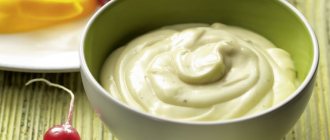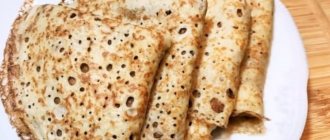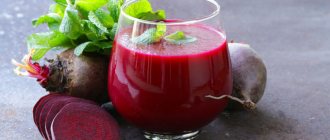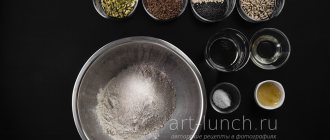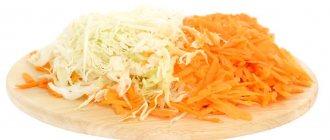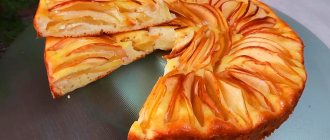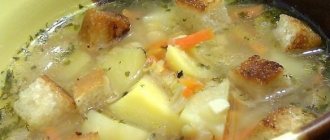Cheese diet for weight loss
When thinking about your diet, it is best to choose cheese for weight loss with a low percentage of fat, carbohydrates and low calorie content. This includes Ricotta, it contains only 174 kcal, this curd cheese is irreplaceable on a diet.
It is worth paying attention to Amber, Oltermanni, Mozzarella, Camembert with mold, feta cheese, Adygei, Tofu. Feta is healthy and tasty; it is higher in calories - 290 kcal per 100 g, but it contains almost no carbohydrates, which provoke rapid weight gain.
You can eat these varieties in the morning, afternoon and evening without fear of gaining weight.
Brynza for weight loss
There is little fat in feta cheese, but a lot of protein, as well as easily digestible calcium, vitamins C, E, B 1, B 2 and useful minerals. The average calorie content of feta cheese is 260 kcal, it is a dietary product, it helps digestion, and those who are on a diet can eat it without fear. Cheese cheese retains its properties perfectly for 2-3 weeks, if it is properly preserved in natural brine.
Adyghe cheese for weight loss
A cheese diet will help you quickly lose weight. In a few days you can lose about three kilograms without harming your health.
The main advantage of this protein diet is a very small amount of carbohydrates. The body begins to consume internal carbohydrate reserves, which reduces adipose tissue.
You need to eat unsalted and hard types every day. Fat content should not exceed 12%.
It is imperative to take multivitamins, since fruits and vegetables are excluded from the diet.
For 3 days
Cheese is an extremely healthy product that deserves a place on any person’s table. But can it be used by those who want to lose weight? The answer to this question can be found in the research of modern nutritionists.
Varieties that promote weight loss
On store shelves you can find a huge number of cheese types, and even the same variety can differ in fat content. A reasonable question arises, what kind of cheese can you eat while losing weight? When choosing a variety, you should give preference to those that are in the safe zone, that is, they have an average calorie content, low fat content, but are still rich in vitamins, minerals and microelements.
Brynza
Nutritionists highly recommend feta cheese for weight loss. 100 g of product contains the daily requirement of protein. In addition, the vitamin-mineral complex maintains the body in working condition. The calorie content of the product varies from 160 to 260 kcal.
Important! The calcium contained in feta cheese is absorbed much more efficiently than in any other type of cheese.
Cottage cheese
This is a fairly large group of cheeses, which includes many different varieties. Curd cheese is on the green list of diets because it is low in calories. It is believed that curd cheeses contain less nutrients than hard varieties. Therefore, it is recommended to include it in the menu not as a component of the main diet, but as a dessert product or snack. It saturates quite quickly and relieves nervous tension. Recommended daily allowance – 70 g.
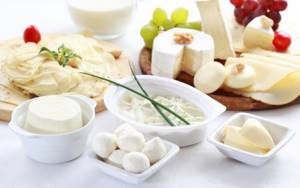
Suluguni
Suluguni cheese is very often used for weight loss, despite its rather high calorie content - 290 kcal. Its rich vitamin and mineral composition saturates the body. Even a small portion of cheese dulls the feeling of hunger for several hours and energizes you. It also lowers cholesterol levels and thins the blood. Suluguni is recommended for sports nutrition as a building material for the muscle frame due to its increased protein level.
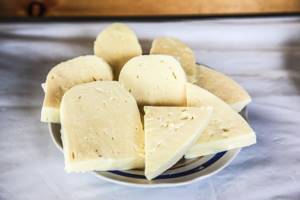
Fused
Processed cheese is less useful for weight loss than other varieties. Sausage cheese can also be included in this group. But processed varieties are used to make healthy sandwiches. They are spread on whole grain bread or crispbread and eaten for breakfast. The calorie content of such cheeses is 220-260 kcal. You can melt the product yourself at home. Melting point – 50˚C. Soft cheese melts more easily, but hard varieties can also be used for these purposes, raising the temperature up to 80˚C.
Ricotta
Is it possible to eat Ricotta while losing weight? Nutritionists favor this variety. Calorie content is only 172 kcal. In addition, the product contains albumin, a protein that is a component of human blood, so Ricotta is quickly absorbed. Fat content is also within the acceptable range - 8-24%.
Chees Feta
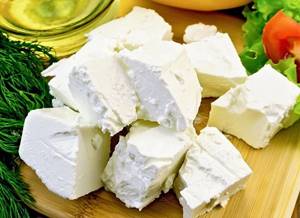
This is a soft cheese made from sheep or goat milk. It is recommended for people intolerant to lactose contained in cow's milk. Feta cheese is very useful for weight loss, as it contains few carbohydrates. The calorie content of the product is quite high - 290 kcal, so it is worth limiting the serving size. Also, when choosing Feta, you should pay attention to the fat content; for some manufacturers this figure can be up to 50%. The optimal fat content in the product is 24 g. Sometimes this type is found under the name Fetaxa.
Cheese is a useful element of dietary and healthy nutrition. It will be a great addition to salads, sandwiches, and snacks. It can be consumed as an independent product as part of a diet and in addition to fruits and vegetables. It is considered advisable to include this product in a diet designed for the gradual loss of excess body weight. You just need to focus on the characteristics (calorie content, protein, fat and carbohydrate content), the volume of the portion eaten and the time of day.
Advantages and disadvantages
All cheese diets have several important advantages:
- Fairly easy to follow, since they are not accompanied by a strong feeling of hunger.
- Simplicity, unpretentiousness, no need to prepare special dishes or count calories consumed.
Also, consuming a relatively large amount of cheese products allows you to get all the benefits described above.
At the same time, the possible harm of this method of losing weight should be taken into account:
- The absence of carbohydrates negatively affects the body’s condition, including worsening the breakdown of lipids and leading to intoxication with the remnants of their incomplete breakdown.
- Excess protein increases the risk of developing some serious diseases of the kidneys, liver, joints and tissues caused by metabolic disorders.
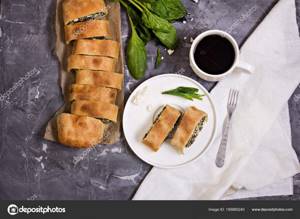
To eliminate the harmful effects of a cheese diet on health, you must strictly adhere to the rules, not exceed its duration and follow the recommended menu.
Diet ration “5 cheerful processed cheeses”
Consequently, the second controversial aspect of the diet is its composition. We present it below (food calculations for a five-day period):
- five pieces of processed cheese;
- five pieces of boiled chicken eggs;
- five pieces of tomatoes;
- five pieces of apples;
- sweet bell pepper (or cucumbers) – also five pieces;
- White wine – 0.7 liters.
- cottage cheese with a low fat content - 1 kilogram.
- Greenery.
Daily diet menu:
- 10:00 – coffee or tea without adding granulated sugar, accompanied by processed cheese;
- 12:00 – egg, tomato and greens:
- 14:00 – one apple;
- 16:00 – bell pepper (or cucumber) with herbs, 200 grams of low-fat cottage cheese;
- 20:00 – one glass of white wine.
The mandatory consumption of a glass of wine in the evening explains why the diet has this name, but in practice many controversial issues and questions arise.
Is it possible to have processed cheese on a diet?
The melted product is useful. It contains vitamins and minerals: zinc, copper, iron, sulfur, phosphorus, potassium, sodium, magnesium, saturated fatty acids.
The average calorie content is 226 kcal. You can eat processed product when losing weight, but only as part of a special diet, for example, the “5 Cheesecake Diet”: only processed product and dry white wine are used.
You can reduce weight by 5 kg in 5 days, but there are contraindications for people who have problems with the gastrointestinal tract, liver disease, or are dependent on alcohol.
Cheese without salt. Eating cheeses and how not to buy counterfeit ones
Natural unsalted hard cheeses are unique storehouses of the most essential nutrients for the human body:
• protein; • saturated animal fats; • B vitamins; • vitamins A, D; • calcium; • potassium; • phosphorus; • magnesium, etc.
This makes this type of cheese an indispensable healer for diseases of the stomach, intestines, endocrine glands, and problems with the hematopoietic and cardiovascular systems. This product occupies a special place in dietary nutrition, preparing diets for athletes, children, and older people.
Unsalted hard cheese finds its rightful place in almost all culinary cultures of the world. It is most unsurpassed as a stand-alone dish or snack. As an ingredient included in salads, soups, hot dishes, sandwiches, pies, sauces, spreads, pizza, pasta, desserts, baked goods, it has no equal. It is an integral option in product lists for various diets. The fact that nutritionists recommend unsalted hard cheese as a food for complementary feeding for babies indicates its significant benefits.
What kind of cheese should be served with wine, cognac, fruit, fresh pastries?.. Of course, unsalted hard cheese, which is capable of soloing or talentedly playing along with the entire culinary orchestra.
Unsalted durum varieties are considered low-calorie and contain the maximum amount of nutrients. They are recommended for nutrition for those who want to regulate their own weight, people with diseases of the gastrointestinal tract (GIT), patients prone to swelling and having problems with the urinary system.
It's all about natural products. How to distinguish real cheese from artificial cheese? First of all, for the price. To prepare a kilogram of product you will need at least 15 liters of natural milk, the presence of natural lactobacilli and rennet starter. The minimum ripening period is about 2 months. So consider it.
The ingredients listed on the label of this product may include:
• milk; • natural starters from microorganisms and (or) animal enzymes; • sodium chlorine.
But what components characterize the unnaturalness of the product:
• milk substitutes; • soy ingredients; • vegetable oils, including palm, coconut; • flavor enhancers, stabilizers, preservatives, dyes, etc.
So before buying unsalted hard cheese, you should think: which is better? Purchase 200 g of a valuable, irreplaceable and useful product. Or save money and harm your own body and wallet. After all, a fake is also not a cheap product.
The fact that 50 g of natural unsalted hard cheese can easily replace the daily intake of vitamins, macro- and microelements speaks for itself.
Sample menu
When creating a menu, it is recommended to use varieties that are not too salty, not too fatty and not spicy. Fat content of 10–12% is considered optimal. You can eat only 1 type of cheese or several, according to your taste, unless otherwise specified in the rules for preparing the diet.
Fasting days
- breakfast – 2 apples, 30 g mozzarella;
- lunch – 70 g Adyghe;
- lunch – 100 g Russian, 1 apple;
- dinner – 1 apple.
- the daily diet consists of 300 g of cottage cheese with 0% fat content and 150 g of any cheese product, which must be divided into equal portions and eaten during the day in 5-6 meals;
- You can drink herbal infusions (from linden, chamomile, mint) and clean water.
- 5 times a day – 70 g of any cheese product with 1 whole grain bread and 50 g of dry wine;
- between meals – 300 ml of pure water or green tea.
Any of these options for a fasting day allows you to lose an average of 1 kg of excess weight.
A cheese diet for 3 days is tolerated by the body without stress or negative consequences. But due to the limited menu it is quite tough.
- in the morning – 2 baked apples with nuts;
- for lunch – 30 g of unsalted cheese;
- in the afternoon – 2 baked apples with nuts and 1 tsp. honey;
- snack – 30 g ricotta;
- in the evening – 2 baked apples.
- in the morning – 2 fresh apples;
- for lunch – 100 g of mozzarella;
- in the afternoon - cabbage salad with 20 g of grain cottage cheese;
- snack – 2 eggs, 30 g feta;
- in the evening – 2 baked apples.
- in the morning – 50 g of ricotta;
- for lunch – 2 fresh apples, 30 g Dutch;
- in the afternoon - a salad of green vegetables with 30 g of granular cottage cheese;
- snack – 30 g mozzarella;
- in the evening - 1 apple, a slice (10 g) of Dutch.
Every day before each meal (20 minutes) you should drink a glass of warm water to speed up metabolic processes and the breakdown of fat deposits. If you feel a strong feeling of hunger, you can drink 200 ml of kefir or yogurt.
For 1 week
With this diet option, you need to eat according to the following scheme:
- in the morning – 2 fresh apples;
- for lunch – 100 g of mozzarella;
- in the afternoon - cabbage salad with 20 g of grated feta;
- snack – 2 eggs, 30 g Russian (low fat);
- in the evening - 2 baked apples, 1 slice of Russian.
- in the morning – 50 g of ricotta;
- for lunch – 2 fresh apples;
- in the afternoon - a salad of green vegetables with 30 g of granular cottage cheese;
- snack – 30 g ricotta;
- in the evening – 1 apple, 1 slice of Dutch.
- in the morning – 2 baked apples with nuts;
- for lunch – 30 g of unsalted cheese;
- in the afternoon – 2 baked apples with nuts and 1 tsp. honey;
- snack – 30 g mozzarella;
- in the evening - 2 baked apples, 1 slice of Russian.
- in the morning – 1 hard-boiled egg, 30 g Dutch;
- for lunch – 30 g feta cheese, 1–2 tomatoes;
- in the afternoon – 150 ml of cream cheese soup with broccoli;
- snack – 200 g of vegetable salad with 30 g of grain cottage cheese;
- in the evening - 100 g of lentil puree, 20 g of mozzarella.
- in the morning – 2 tomatoes, 30 g Dutch;
- for lunch – 100 g of granular cottage cheese;
- in the afternoon – 150 g chicken breast, 2 cucumbers, 30 g mozzarella;
- snack – 200 ml pumpkin smoothie with yogurt;
- in the evening - 150 g of stewed vegetables, 30 g of ricotta.
- in the morning - tomato salad with Adyghe cubes (20 g);
- for lunch – 200 ml of kefir;
- in the afternoon – 200 ml of cheese soup, 150 g of boiled fish;
- snack – 2 apples;
- in the evening - 200 g of carrot salad with 25 g of grated cheese.
- in the morning – 150 g of pea puree, 30 g of Dutch;
- for lunch – 30 g of nuts without additives;
- in the afternoon – 100 g grilled veal, potatoes (2 pcs.), 30 g feta cheese;
- snack – 200 ml yogurt, 1 egg;
- in the evening - 2 tomatoes, 30 g feta.
You can satisfy a strong feeling of hunger with cabbage salad with lemon juice or low-fat kefir.
"10 cheeses"
This menu may include only one variety or several (optional), but not necessarily 10 different ones, as you can guess from the name. “10 cheeses” means that within 10 days, eating mainly cheese, you can lose 10 kg of weight. You are allowed to use only hard ones - Dutch, Russian, Cheddar and others, alternating them to your taste.
- 8:00 – 200 ml of milk;
- 10:00 – cucumbers, greens;
- 13:00 – 4 tomatoes;
- 16:00 – 1 egg;
- 18:00 – 100 g of boiled chicken breast.
- 8:00 – baked potatoes (2 pcs.);
- 10:00 – 200 ml kefir;
- 13:00 – 150 g of cabbage salad;
- 16:00 – 200 ml of milk;
- 18:00 – 200 g of boiled carrot salad.
- 8:00 – 150 g of pea puree;
- 10:00 – 200 ml of yogurt;
- 13:00 – 200 g of boiled asparagus;
- 16:00 – cucumbers, greens;
- 18:00 – 100 g bean puree.
- 8:00 – 200 ml of milk;
- 10:00 – 2–3 bell peppers;
- 13:00 – 150 g boiled broccoli;
- 16:00 – lettuce salad;
- 18:00 – 100 g of boiled red meat.
- 8:00 – 2 tomatoes, greens;
- 10:00 – 200 ml kefir;
- 13:00 – 200 g eggplants stewed with garlic;
- 16:00 – cucumbers, greens;
- 18:00 – 150 g steamed fish, 50 g celery.
After 5 days on a diet, you should take a break from proper nutrition (1-2 days) to consolidate the results. Then you need to repeat all the days in the same order.
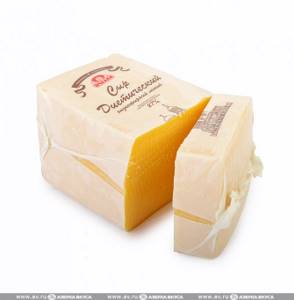
During the entire course you can drink any sugar-free drinks. The total daily volume of liquid should not exceed 1 liter, since the menu includes a large number of vegetables containing water.
On sandwiches with cheese
The main point of losing weight on cheese sandwiches is that only this dish is included in the menu, but the daily caloric content of the diet should not exceed 1200 Kcal. When making sandwiches you must follow these rules:
- The basis should be bread, whole grain or bran bread in a total amount of no more than 500 g per day.
- Cheeses are cut into thin slices, their daily intake is determined in accordance with calorie content: low-calorie ones can be taken more, fatty ones - less.
- As a supplement, it is allowed to use cucumbers, tomatoes, herbs, and lettuce.
- The maximum weight of one sandwich is 15 g.
There is no menu as such for this cheese diet. You just need to eat 1 sandwich every hour. Women are allowed to eat 12 sandwiches per day, men - 16. In between, you can drink clean water or green tea. The duration of the course is no more than 10 days.
Wine and cheese
This menu is also quite simple. In 1 day you are allowed to consume:
- 350 g of cheese products;
- 350 ml dry red wine;
- 7 loaves of bread.
The specified amount is divided into 7 servings and consumed at regular intervals. You can stick to this diet for no more than 3 days.
For a day
This fasting meal is used for one day.
The menu includes up to 100 g of cheese, divided into five parts. You can add apples to it for every meal and water or green tea.
For 3 days
For a week

The principle of nutrition is based on a three-day diet, but low-calorie foods are added, such as boiled beef, rabbit meat and lean boiled fish.
It is allowed to include steamed rice and stewed vegetables in the menu. But the basics remain cheese, low-fat cottage cheese and kefir (in the evening). Natural low-fat yogurt is also present in the weekly diet.
While losing weight, you need to drink 1.5-2 liters daily. clean water.
Cheese with wine
Dietary curd cheese
Low-fat dietary curd cheese is also prepared at home, to which herbs and spices are added. For preparation you will need cottage cheese in the amount of 400 g, 1 glass of milk with a fat content of 6%, 1 tsp. soda and 2 eggs. The ingredients are mixed and cooked for 20 minutes. Having completed this procedure, a load is placed on top of the resulting mass. Cheese such as Mozzarella is also made from cottage cheese. For this you will need 2 tbsp. lemon juice, 2 liters of low-fat milk (2.5%), 2 liters of water, pepsin and salt. First, place the milk in a saucepan and heat it with the addition of lemon juice. Then drain the liquid and transfer the resulting cottage cheese to another bowl. Separately in 2 tbsp. We dilute pepsin in water (1 tsp), and then pour the resulting solution into the cottage cheese. We put the rest of the water on the fire and boil, and then lower the cottage cheese into it. When the mass becomes viscous, it must be caught using a slotted spoon. We give it the desired shape and put it under the press.
Contraindications
The cheese diet, as a type of protein and low-carbohydrate weight loss methods, has a number of contraindications. It cannot be followed if you have the following diseases:
- heart, kidney or liver failure;
- metabolic disease;
- digestive system disorders, chronic constipation.
Also, such weight loss techniques are contraindicated if you are allergic to milk or individual lactose intolerant. In all other cases, strict adherence to the recommended duration and nutritional rules is required. This will help avoid adverse reactions and harm to health.
Disadvantages and contraindications of the “5 processed cheese curds” diet
The consequence of an excessively low calorie diet is a slowdown in metabolism, so the return of lost kilograms after completing the diet is almost inevitable.
A poor diet can lead to deterioration of intestinal function; the diet is often accompanied by constipation.
The classic version of the diet (with white wine) is contraindicated for those who have had or have problems with alcohol.
White wine can be replaced with low-fat kefir.
“5 processed cheeses” are not recommended for people with gastrointestinal diseases and endocrine disorders, as well as for children and adolescents, old people and weakened people, pregnant and lactating women.
How much cheese can you eat per day on a diet?
Nutritionists advise: you need to take into account caloric content in order to understand how much cheese to eat when losing weight. You can consume 70-100 grams of solids per day, this will not spoil your figure and will benefit the body.
The one with mold, you can afford 50-70 grams per day. Homemade dietary curd product, even in an amount of 200 grams, is not terrible.
But you should be wary of counterfeit products containing palm oil and other additives. They are harmful in any quantity.
What is the manufacturer silent about?

In addition to melting salts, modern cheeses can include a whole list of potentially dangerous components that turn a product acceptable for diet into a downright harmful one. Among them are dyes, flavors, flavoring and aromatic additives, antioxidants and preservatives.
Moreover, the use of preservatives in the product formulation is not necessary. Because even without these substances, thanks to the special heat treatment of the cheese mass, as well as the tightness of the packaging in which the finished cheese is placed, the product can be stored for up to 180 days! Preservatives are designed to increase this period several times!
Quitting the diet
At the end of the cheese diet, you can’t pounce on your usual food, otherwise all the lost kilograms will come back. Every day you need to add a small amount of carbohydrates to your diet, gradually increasing their amount, to allow the digestive system to return to normal operation.
At the same time, it is important to provide not only a low-calorie, but also a healthy diet in order to prevent problems with the functioning of the gastrointestinal tract.
First of all, you should include healthy dishes in the menu:
- low-fat meat and fish broths;
- light soups;
- porridge with water or milk;
- fruit purees.
Such food will help normalize digestion and maintain the results achieved in losing weight.
It is also recommended to continue to eat smaller meals for 2 weeks, avoid late dinners, and drink at least 1.5 liters of water per day.
Broccoli quiche with melted cheese
Processed cheese can be used not only in sandwiches, but also in more interesting dishes. For example, bake a quiche with melted cheese and broccoli.
Composition of ingredients
To prepare quiche you will need a glass or Teflon baking dish and the following ingredients:
- Ready puff pastry;
- a pair of eggs;
- fresh or frozen broccoli;
- sliced processed cheese;
- salt and spices;
- ½ tsp. butter.
Traditionally, quiche is prepared using shortcrust pastry. But it is very fatty and high in calories, so it is better to replace it with puff pastry.
Step-by-step cooking process
- The mold must be greased with oil, and the dough sheet must be folded in half and rolled out with a rolling pin to the desired shape.
- The dough should be placed in the mold so that it completely covers the bottom, and leave sides of 1.5 - 2 cm so that the filling does not leak out.
- Broccoli needs to be cooked or fried a little. The broccoli should not be completely softened, otherwise during the baking process the quiche will turn into green mush.
- The eggs need to be broken, the whites and yolks mixed, salt and spices added.
- The sliced cheese needs to be cut into small pieces and spread evenly onto the dough.
- You should also distribute small broccoli forks evenly over the dough.
- Then you need to pour the egg mixture over everything and place it in an oven preheated to 200 degrees for 20 - 30 minutes.
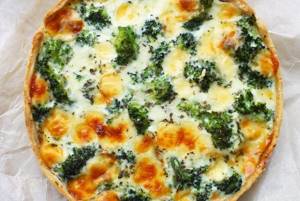
- The finished pie needs to be cut into pieces.
Quiche can be served either hot or cold. Its calorie content is about 380 kcal.
What are they and what are the benefits of cheese for the human body?
It is not for nothing that cheese is one of the oldest human foods. It contains many useful substances and vitamins. It is recommended for use by athletes, children, pregnant women and nursing mothers, as it contains a large amount of mineral salts and calcium.
Classification
In order not to get lost in the huge variety of cheeses, you need to know by what principle and how they are classified.
According to the production method, the following varieties are distinguished:
Hello, dear readers of my blog! We continue the series of articles about weight loss products and today we will find out whether it is possible to eat processed cheese on a diet?
The information on all nutrition resources is different, so it would be nice to objectively understand the situation. To eat or not to eat? - that is the question!
How to store
Knowing how to store homemade cheese in the refrigerator, you don’t have to worry about the product’s longevity, since both the temperature and humidity can be adjusted. So, it is best to keep delicate and capricious fermented milk products away from the freezer, because it is usually much colder there.
The ideal place is in the vegetable compartment . They must first be wrapped in cling film. By the way, tightness is the guarantee that the product will not weather or become saturated with foreign odors.
Homemade processed cheese can be stored in the refrigerator for several days - up to 14. We recommend that after 6-7 days you reheat it, melt it again to a liquid state and use it as a sauce for porridge, pasta, and salads.
Let's understand the composition
The most important thing in any product is its composition. It determines how acceptable this or that food is for a person. Third-party nutrition sources claim that processed cheese is very healthy and nutritious. They are recommended to be eaten on an ongoing basis, as they also contain some herbs and beneficial additives.
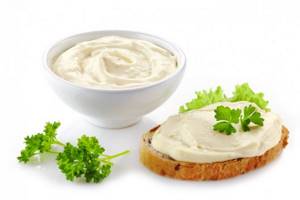
As usual, no specific information. I suggest, dear reader, to turn on critical thinking and objectively evaluate all the pros and cons.
This product is made from cottage cheese, milk powder and rennet cheeses.
Rennet are cheeses that are made from rennet with the addition of milk through special processing.
The calorie content of the product is quite high. On average there are 225-300 kilocalories per 100 grams. However, despite its calorie content, the nutritional value is extremely low. And the reason for this is the almost zero percentage of carbohydrate content.
Per 100 g there are:
- Fats - 13.6 g.
- Proteins 24.4 g.
- Carbohydrates - 0 gr.
- Water - 62 gr.
It turns out that from the point of view of nutrition and digestibility, the product is useless for the human body. They eat it more for entertainment than to satisfy the physical need for food.
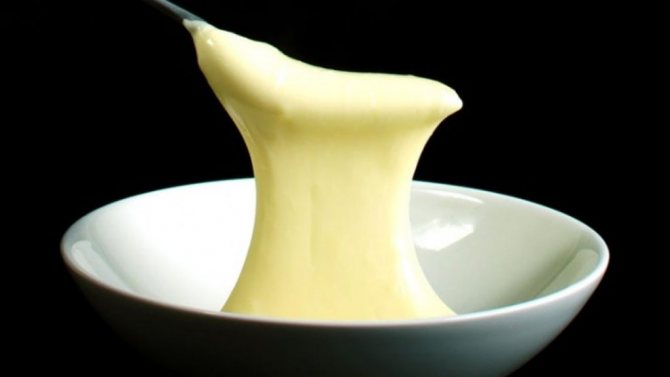
But there is protein here, which is needed for building muscles, some readers might think. I must disappoint you, this is absolutely not true. Animal protein and human protein are two completely different substances with different structures. What is suitable for building cow tissue will not be suitable for humans.
These substances have different structures. In order for our body to absorb amino acids from an animal molecule, it must first be disassembled, then the necessary substance must be obtained, and only then it must begin to build its own molecule.
Doctors say in this case, this protein is absorbed by so many percent, never 100%
Can you imagine what a long and illogical process it is? The remaining substances simply rot inside the body, releasing cadaveric poison.

Additionally
After analyzing several sources, I discovered that the cheese also contains:
- Cholesterol – 65 mg.
- Ash – 4.5 g.
- Mono- and disaccharides – 2.4 g.
- Starch – 0.3 g.
- Saturated fatty acids – 11.2 g.
- Organic acids – 0.5 g.
The stated composition is based on the “
Friendship ” cheese, which is well known in all regions of our country.
What immediately catches your eye is the fairly high cholesterol content, which is one of the main enemies of a person losing weight. You should also pay attention to starch, which is known to increase insulin levels in the blood.

What conclusion can be drawn based on the information provided? Processed cheese is unlikely to be suitable for a person losing weight. It is high in calories, harmful, and difficult to digest.
On one of the sources I found a phrase that really caught my attention. I share with you:
“Processed cheese is considered dead cheese. All substances that could somehow interact with our body are killed during industrial processing. They should not be offered to children, as they contain harmful fats, salts and other foreign components.”
I note that this opinion was published on a full-fledged online publication (I will not mention the name). In Switzerland, which is the birthplace of this product, the so-called “delicacy” is considered the cheapest and low-quality type of cheese.
It is not customary to consume it in high strata of society, as it is believed to be hazardous to health.
When will this information reach us...

Our caterers know firsthand that processed cheese is an expired cheese or cheese product processed in production, with the addition of other equally dangerous ingredients. And when the resulting mixture does not suit the taste, the processed cheese is also smoked in order to completely kill the taste.
Other types of cheese curds
Separately, I would like to dwell on other types of processed “delicacies”, in particular, talk about glazed curd cheese. TV advertisements convince us that eating these dairy products is healthy. It is also fashionable today to say that they help get rid of excess weight.
Glazed cheese curd can hardly be called a real dairy product. If you go to a supermarket and read its ingredients, you may be truly horrified.

Today, its composition is more reminiscent of a chemical laboratory than a healthy ingredient. The glazed shell is usually made from chocolate with low quality fats, which a priori contains a lot of sugar.
Is it suitable for diet? It seems to me that the answer is obvious.
“Processed cheese” for weight loss
Shortly before the First World War, a method of preparing this delicate product was discovered quite by accident in Switzerland.
In the small town of Thun, they made a lot of cheese, but were unable to sell it, but to prevent it from spoiling, they tried to digest it, that is, melt it.
After that, the cooking process was constantly improved, and as a result, several types of processed cheeses and curds appeared.
Composition of processed cheese
The composition of processed cheese curds allows them to be used during strict diets to obtain valuable substances. This is a dairy product, so it contains balanced amino acids, a high concentration of fat and protein, phosphorus and vitamins, and essential calcium salts.
As mentioned earlier, processed cheeses are produced on the basis of hard cheeses, which are not as well digestible as processed cheeses. They are often made from Rossiysky, Poshekhonsky and other famous cheeses. During the production process, dairy elements, cream, butter or milk powder are added to them. And for a soft consistency, melting salts are used.
Based on technology and chemical composition, processed cheeses are divided into groups:
- Sliced cheeses are made from rennet cheeses with a fat content of 50 to 70%, flavored with dairy products. This cheese can be cut into slices, it has a characteristic cheese taste.
- Sausage cheeses are produced on the basis of low-fat cheeses, additionally some types of rennet cheeses and some dairy products are added to them, the main additive is cumin or pepper, and smoked casings.
- Cheeses are spreadable, they have a bright cheese flavor, and are high in fat.
- Sweet cheeses. Sweets and fillers are added to them to obtain additional aroma and enhance the taste. For this they use: honey, coffee, cocoa, chicory, nuts, various fruit syrups.
The benefits of processed cheese for weight loss
Unlike hard cheeses, the digestibility of processed cheeses is almost one hundred percent, and this prevents the formation of cholesterol plaques. This valuable product contains the necessary phosphorus and calcium, thanks to which we can improve the appearance of the hair, the nails will become dense and the skeletal system will be strengthened.
- And the fats, which are abundant in these cheeses, although high in calories, contain fat-soluble vitamins and carry polyunsaturated fatty acids and vitamins A, D, and E to the body.
- Processed cheeses contain a lot of casein; it is a high-quality protein and contains all the essential amino acids. Only 2% lactose, which means it will not cause problems with absorption. And it contains no carbohydrates at all. With low fat content, you can do fasting on cheese and lose weight.
- Processed cheese cheeses do not have the cheesy aftertaste that other hard cheeses have, and there is no characteristic aroma. But these cheeses have a long shelf life, up to six months.
What to look for when choosing cheese curds for your diet
Processed cheese contains slightly more sodium than hard cheese. People with problems with the cardiovascular system and experienced hypertensive patients should not abuse this product.
Some cheese curds contain phosphate food additives and unnatural Eshki, and no salt is spared. Keeping in mind that these ingredients can cause allergies, please read the ingredients carefully.
Especially for people suffering from kidney failure, excess phosphates are undesirable; they are also harmful to bone density, and this will lead to bone fragility over time.
In the process of preparing processed cheese curds, for faster ripening, citric acid is introduced into the cheese, so for those who have high acidity of gastric juice, limit the portion of cheese to a minimum.
Another advantage of cheese is its high calorie content, so just a little cheese gives good saturation; if you are on a diet, limit the portion, let it be a delicacy.
Young children should not be given processed cheese curds yet, due to their calorie content and content of melting salts. It’s better to prepare them oatmeal with milk for weight loss without sugar, but with dried fruits.
The most important point to consider when choosing cheeses is an unscrupulous manufacturer who, taking advantage of the popularity of the product, offers a low-quality fake made from surrogate products at a lower price. Be careful not to harm your health or support unscrupulous “grabbers”. High-quality processed cheese costs a little less than hard cheeses.
Processed cheese is made from recycled materials, which accumulate from rennet cheeses that do not meet the standard, that is, from unripe cheese mass, or from dairy products whose shelf life is running out. Don't let this scare you, as the cooking process produces wonderful, nutritious cheese.
You should not use a cheese product for your diet, because for its production, to reduce the cost of production, butter is replaced with vegetable oils such as palm or rapeseed; the value of such a product is questionable. It can be used in a dairy diet for weight loss and in making sauces.
Do not buy processed cheese in a plastic form if the letters PS are on the bottom; these symbols indicate that the container is made of polystyrene, which has long been banned for use for food storage.
In European countries, plastic packaging made of polypropylene is used; the letters PP are stamped on the bottom of such forms.
Recipes with processed cheese
Dietary processed cheese soup
It doesn't take long to cook and it's not difficult. Fry onions in butter in a frying pan, bring until golden brown, then add a clove of garlic and white wine, cook until the wine evaporates. When the wine has evaporated, add a little thyme and pour into the pan with the broth. After the soup boils, sprinkle with chopped processed cheese; when it melts, turn off the soup.
The sauce, seasoned with cheese, will make its consistency thick and rich in taste, the cheese can be grated before adding to the sauce, or you can break it finely, it will melt well anyway.
Source: https://slimim.diet/6577/cream-cheese/
History in a nutshell
As I mentioned above, the product was first produced in Switzerland. The start of production dates back to 1911. Two famous scientists Fritz Stettler and Walter Gerber, who worked for the Ministry of Defense, came up with a way to reduce production costs while increasing the company's profits.

The first person to patent a method for producing dairy “delicacies” was James Kraft himself, the creator of the Kraft Foods Corporation.
During the First World War, James received the first major order for his patent. It was necessary to supply food to feed the entire French army. The main criterion was shelf life, so no one could vouch for the quality. This is still the case today.
Disadvantages and advantages of the “5 fun processed cheese curds” diet
In fact, such a diet has a right to exist, although it is preferable to make certain adjustments to it. After all, according to experts in the field of nutrition, only those who have previously consumed a much larger amount of food per day will be able to lose weight from it. Moreover, even they may simply not get the slightest results. If you can get an effect from such a diet, it is only due to the remaining healthy foods, but not at all from wine and processed cheese.
True, you can leave the wine entirely. A glass of quality white wine before bed can actually be beneficial. Just not on an empty stomach. It is preferable to add one apple to it. In this case, over a 5-day period, instead of five, ten apples will be consumed, which will not in any way negatively affect your figure. But processed cheese should be replaced. For example, for unsalted cheese or some hard cheese such as “Adygei” or “Russian”. You can eat a small piece of cheese in the morning with a small piece of toast - it will still be much healthier than a whole processed cheese.
Sources
- https://tvoy-ves.ru/mozhno-li-est-plavlennyj-syrok-na-diete/
- https://DietyIOtzyvy.ru/diety/5_veselyh_plavlennyh_syrkov
- https://www.neboleem.net/dieta-5-plavlennyh-syrkov.php
- https://slimim.diet/7422/5-syrkov/
- https://jasmogu.ru/diety/nizkokaloriynye/1000000121.html
[collapse]
What to remember
Processed cheese should not be consumed while on a diet. I would even say that it should be excluded from your diet altogether. It does not contain any nutritional value and does not have fat burning properties. Everything is exactly the opposite.
That's all for me. Subscribe to the blog and leave your comments below.
Cheese is a product that can be both an enemy and a friend of a good figure. However, to the question is it possible to eat cheese while losing weight, the answer is unequivocal - yes! You just need to choose a low-fat product and regulate its quantity. For example, eat a sandwich for breakfast. This will give the body the necessary protein - a building material for muscles. You can add a low-fat product to different dishes. This will keep you full and help you lose weight.
Benefit
If you regularly include cheese in your diet while losing weight, it will have the most positive effect on your health, as it has a number of beneficial properties:
p, blockquote 10,0,0,0,0 –>
- improves digestion;
- is a source of potassium, calcium and proteins;
- normalizes blood circulation;
- increases performance, gives a boost of vigor and energy;
- activates cellular respiration;
- relieves insomnia;
- has a calming effect on the nervous system, helping to cope with stress, thereby reducing the production of cortisol, which promotes fat deposition and stimulates appetite;
- normalizes the processes of growth and development in childhood and adolescence;
- increases erectile capabilities in men;
- Promotes visual acuity and prevents eye diseases.
It is not surprising that it has such a complex effect on the body. After all, it is a storehouse of easily digestible proteins, milk fat, amino acids, mineral salts, water- and fat-soluble vitamins (A, B1, B5, B12, C, E, D, PP).
p, blockquote 11,0,0,0,0 –>
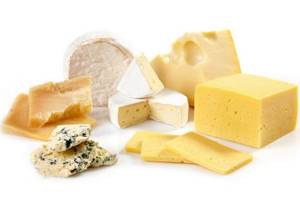
p, blockquote 12,0,0,0,0 –>
According to production method
p, blockquote 13,0,0,0,0 –>
- Fresh is cottage cheese, which in many countries is considered a cheese product.
- Soft - has a crust made of mold: with a washed crust (it is treated with alcohol) and fluffy (with mold).
- Semi-hard and hard: boiled (Parmesan, mozzarella) and uncooked (Gouda, cheddar).
- Brine: feta cheese, suluguni, feta.
- Blue - with mold (Roquefort).
- Fused: orbit, viola, friendship, amber.
- Smoked: sausage, braid.
Based on this classification, it is recommended to eat fresh and hard cheeses when losing weight. Those with mold are expensive and require getting used to their smell and taste. Despite the low calorie content of pickled varieties, they contain too much salt, which disrupts the body's water balance and promotes the formation of edema, which is unacceptable when losing weight. Processed cheese contains too many additives, dyes and flavors, so you should be careful with them. It is also not recommended to use smoked ones, since this method of preparing products is prohibited both in diets and in proper nutrition.
p, blockquote 14,0,0,0,0 –>
By raw materials
p, blockquote 15,0,0,0,0 –>
- Cow: more than 85% of varieties.
- Goat: chevroux, manchego.
- Sheep: feta cheese.
- Kobyliy: kurt.
- Mixed: feta (sheep + goat milk).
The healthiest one comes from goat's milk, but it is far from dietary, as it contains a large amount of fat. Sheep and mares are difficult to obtain. Therefore, all that remains to lose weight is cow fat.
p, blockquote 16,0,1,0,0 –>
By fat content
p, blockquote 17,0,0,0,0 –>
- Dietary (10%).
- A quarter fat (20%).
- Bold (30%).
- Three quarters fat (40%).
- Bold (45%).
- Very fatty (50%).
- Creamy (60%).
- Maximum creamy (85%).
Many varieties have a similar gradation. Therefore, it is important to carefully study the packaging and buy cheese with no more than 40% fat content. The best option is lean.
p, blockquote 18,0,0,0,0 –>
By type of starter
p, blockquote 19,0,0,0,0 –>
- Whey (ricotta).
- Rennet.
- Fermented milk: grated (green), curd.
Fermented milk is the most natural, made from skim milk, which is fermented using lactic acid starter. It can be safely eaten on any diet.
p, blockquote 20,0,0,0,0 –>
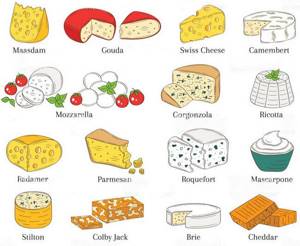
p, blockquote 21,0,0,0,0 –>
According to the presence of additives
p, blockquote 22,0,0,0,0 –>
- With nuts.
- With greens.
- With onion.
- With sugar.
- With mushrooms.
- With salmon.
- With chocolate.
- With ham, etc.
Want to lose weight without giving up cheese? Then it’s better not to buy it with additional flavors: to extend its shelf life, manufacturers add a lot of preservatives to the product.
p, blockquote 23,0,0,0,0 –>
It is a fact. Until now, no one can calculate how many varieties of cheese are produced in the world today. The largest review of this product was made by André Simon, a French cheese maker. His treatise “On the Cheese Business” mentions 839 types; he wrote it over 17 years.
Is it possible to eat cheese on a diet?
The product is very rich in proteins and calcium. But this is a high-calorie food, so not everyone can benefit from eating cheese while on a diet. If you make it at home or choose low-fat varieties, you will not gain weight and will not go hungry. You need to be careful with salty foods - salt retains water in the body, reducing the effectiveness of the diet. Some varieties contain a lot of cholesterol, so you need to reduce your consumption of this product. But there are special diets that will help you get rid of unnecessary volume and weight.
Quiche with spinach
A similar pie can be made with fresh or frozen spinach.
Composition of ingredients
- Ready puff pastry;
- a pair of eggs;
- fresh or frozen spinach;
- sliced processed cheese;
- salt and spices;
- ½ tsp. butter.
Step-by-step cooking process
- The dough should be folded in half, rolled out and placed in a greased pan.
- The cheese needs to be cut into small pieces.
- The eggs need to be beaten with spices.
- Fresh spinach should be chopped into strips 5 mm wide and sautéed until the greens begin to darken.
- Next, you need to spread the spinach over the dough, put the cheese on top and pour the egg mixture over it.
- Bake in the same way as the previous one.
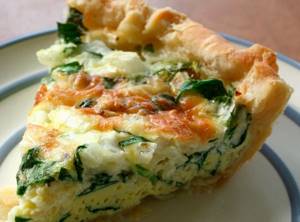
If you use frozen spinach, it is better to use one that has been sautéed before freezing. Just heat it in a frying pan until completely thawed before adding it to the pie.
What kind of cheese can you eat while losing weight?
When thinking about your diet, it is best to choose cheese for weight loss with a low percentage of fat, carbohydrates and low calorie content. This includes Ricotta, it contains only 174 kcal, this curd cheese is irreplaceable on a diet. It is worth paying attention to Amber, Oltermanni, Mozzarella, Camembert with mold, feta cheese, Adygei, Tofu. Feta is healthy and tasty; it is higher in calories - 290 kcal per 100 g, but it contains almost no carbohydrates, which provoke rapid weight gain. You can eat these varieties in the morning, afternoon and evening without fear of gaining weight.

Brynza for weight loss
There is little fat in feta cheese, but a lot of protein, as well as easily digestible calcium, vitamins C, E, B 1, B 2 and useful minerals. The average calorie content of feta cheese is 260 kcal, it is a dietary product, it helps digestion, and those who are on a diet can eat it without fear. Cheese cheese retains its properties perfectly for 2-3 weeks, if it is properly preserved in natural brine.
Adyghe cheese for weight loss
Adyghe contains little fat, but is rich in calcium, phosphorus, and fat-soluble vitamins. The calorie content of Adyghe cheese is only 240 calories. The enzymes contained in it improve the digestion process, normalize the intestinal microflora and the functioning of the nervous system. It is believed that drinking Adyghe helps cope with anxiety, improves sleep and mood. This dietary product is often included in menus for overweight people with a tendency to obesity.
Tofu cheese for weight loss
Eating Tofu promotes weight loss. This fermented milk product is made from soy milk and has unique beneficial properties. It contains a large amount of vegetable protein, amino acids, iron, calcium, which the body requires. Does not contain cholesterol, reduces its level in the blood. The calorie content of tofu soy cheese is low - on average 100 kcal, therefore, by consuming it, you can enjoy it and lose excess weight.
There is a special diet based on Tofu, which is easy to follow. Tofu is filling, but easily digested by the body and acts as a mild laxative. In three you can lose several kilograms:
- Breakfast: Tofu and vegetable salad without oil and spices.
- Lunch: any Tofu dish, green tea.
- Dinner: vegetable salad and Tofu.
- Repeat the diet after four months.
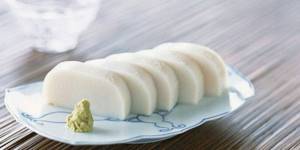
Ricotta for weight loss
Italian Ricotta is produced from whey with a low amount of fat, so it has a lot of albumin proteins, and the fat content is one of the lowest. Want to know how many calories are in ricotta? In 100 grams there is no more than 174, but this does not prevent it from being nutritious and tasty. This dietary product has a calming effect on the liver and strengthens the immune system. So you can not be afraid to prepare delicious desserts, snacks and sandwiches with Ricotta, but this does not apply to the saltier types: smoked and aged, they are salty.
Mozzarella for weight loss
Mozzarella is a source of proteins, vitamins, and microelements that a person needs; it does not cause digestive problems and is useful at any age. The calorie content of 100 g of mozzarella can be 350 kcal, but low-fat varieties have different indicators. For example, the energy value of low-fat mozzarella is 160 calories. Therefore, it is worth adding it to various dishes without fear of gaining weight.
Low-fat hard cheeses. List of low-fat cheeses
Low-fat cheeses are made from skim milk. That is, the cream is first skimmed from the milk, then the cheese is made.
But it will be difficult to call it completely low-fat, because the percentage of fat content will still be present, but in different percentages:
- low-fat - fat content less than 15%;
- light - fat content 15-40%;
- normal - fat content 40-60%;
Low-fat cheese is almost as good as fatty varieties in terms of taste and beneficial properties. And in some respects it even surpasses them.
Here are some of them:
- The well-known soy cheese Tofu has a fat content of 2-4%;

- Granular cottage cheese contains no more than 5% fat content;
- Riccotta cheese has only 9%;
- Smoked Chechil cheese – fat content 10%;
- Mozzarella cheese contains no more than 15% fat;
- Viola Polar cheese has a fat content of 16%;
- Regular Chechil cheese contains 18% fat content;
- Feta cheese Arla Apetina has a fat content of no more than 20%;
- Cheese Arla Apetina Light -25%;
- Galbani Mozzarella Light cheese—fat content 30%;
- Salad cheese Favita – fat content 30%;
- Chevrefin cheese - fat content 40%;
- Kaserei Champignon cheese – fat content 15%;
- Gaudette cheese - its fat content is only 12%.
Hard cheeses
Hard cheeses are most widespread, these include: Romano, Emmental, Raclette, Grano Padano, Leiden, Gruyere, Parmesan, Pecorino, Maasdam, Frisien, etc. Hard cheeses contain lecithin, which affects the proper metabolism of fats.
Lecithin is part of the structure of cell membranes, is responsible for their permeability, normalizes cholesterol levels, and stimulates the work of enzymes to break down fats.
Cheese production is a long process. And ripening takes up to 3 months or more.
Cheese features:
- Swiss - 45% fat mass, matures in 5-6 months. It is cylindrical in shape and has small eyes in cross section. Sweetish taste, pleasant aftertaste. The most famous: Moscow, Altai, Swiss, Soviet.
- The Parmesan type is very famous and loved by everyone. Its structure is slightly crumbly and breaks easily. Ripens for at least six months. Its taste and aftertaste are refined and unforgettable for a long time.
- Dutch - small eyes when cut, color from bright yellow to dark yellow. Salty taste and delicate slightly sour aftertaste. Popular types: Kostroma, Dutch
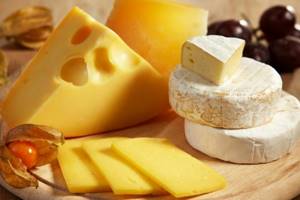
. - Cheddar type - the head is round, slightly flattened on the sides. With a soft consistency, there are no eyes when cut. It has a salty taste, a little sugary.
- Russian - cylindrical in shape, pleasant consistency. Creamy, sweetish taste, very pleasant. The most revered is Russian.
- Smoked type - they have a well-defined smoked taste, a brown rind, and a yellow color when cut.
Is it possible to have processed cheese on a diet?
The melted product is useful. It contains vitamins and minerals: zinc, copper, iron, sulfur, phosphorus, potassium, sodium, magnesium, saturated fatty acids. The average calorie content is 226 kcal. You can eat processed product when losing weight, but only as part of a special diet, for example, the “5 Cheesecake Diet”: only processed product and dry white wine are used. You can reduce weight by 5 kg in 5 days, but there are contraindications for people who have problems with the gastrointestinal tract, liver disease, or are dependent on alcohol.
Recommendations
How to choose a quality one?
p, blockquote 45,0,0,0,0 –>
Calorie content should be no more than 300 kcal per 100 g of product, fat content should not exceed 40%. The lower these indicators, the better the weight loss results will be. The composition should contain only natural ingredients: sourdough and milk, possibly adding spices. Don't forget to look at the expiration date. The wax coating must be smooth, solid, uniform in color, without blisters, damage or white deposits.
p, blockquote 46,0,0,0,0 –>
The color is milky, with a yellowish tint. The smell should not be sour or pungent. It squeaks on the teeth - it contains starch, it’s better not to buy it. A sticky consistency indicates a violation of manufacturing technology. The taste of a quality product is salty with a creamy tint.
p, blockquote 47,0,0,0,0 –>
When is the best time to eat?
p, blockquote 48,0,0,0,0 –>
The optimal time is for breakfast. According to scientific research, in the morning the stomach is able to fully absorb all the nutritional elements of cheese. For lunch, you can use it as an ingredient in a dietary dish (cream soup, julienne, vegetable salad). For dinner, you can eat a small slice, since, according to the principles of proper nutrition, the last meal should be protein. But late in the evening, at night, it is not recommended to eat it either when losing weight or with a normal diet. Proteins and fats will weigh down your stomach and slow down the digestion process.
p, blockquote 49,0,0,0,0 –>
In any form?
p, blockquote 50,0,0,1,0 –>
Exclusively fresh. A baked cheese cap and a viscous mass of creamy soup are the height of culinary sophistication, but they are of little use. During heat treatment, the protein is destroyed and the amount of fat increases. And try not to eat it cold. Cut a piece and keep at room temperature for at least half an hour.
p, blockquote 51,0,0,0,0 –>
How to store it correctly?
p, blockquote 52,0,0,0,0 –>
On the top shelf of the refrigerator for no more than a week. As soon as mold appears on it, it becomes hard, covered with a yellow crust or droplets of liquid, do not risk your health - throw it away.
p, blockquote 53,0,0,0,0 –>
With the world - one by one. The leader in production is America. The leader in consumption is Greece. The best product is made in Switzerland. The experts are the French.
Cheese diet for weight loss
A cheese diet will help you quickly lose weight. In a few days you can lose about three kilograms without harming your health. The main advantage of this protein diet is a very small amount of carbohydrates. The body begins to consume internal carbohydrate reserves, which reduces adipose tissue. You need to eat unsalted and hard types every day. Fat content should not exceed 12%. It is imperative to take multivitamins, since fruits and vegetables are excluded from the diet.
For 3 days
A special cheese diet for 3 days will allow you to lose 3 kilograms. You don’t have to be afraid to eat this product and cottage cheese, but be sure to drink more liquid. This is an effective method for rapid weight loss. Here is an example of a menu for three days:
- Breakfast: unsweetened tea, coffee, cheese.
- Second breakfast: boiled egg, tea.
- Lunch: 100 g cheese, 200 g meat (lean).
- Afternoon snack: 250 g of fresh cottage cheese.
- Dinner: low-fat kefir or yogurt.
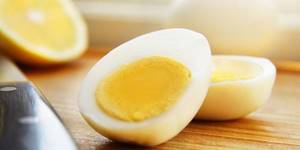
- Breakfast: 1 bell pepper, cheese, herbal tea.
- Second breakfast: tea, boiled egg.
- Lunch: boiled meat with a slice of cheese, mineral water.
- Afternoon snack: 2 fresh cucumbers with cheese.
- Dinner: cheese, yogurt or kefir.
- Breakfast: 2 fresh tomatoes, low-fat cottage cheese (150 g).
- Second breakfast: 100 g of asparagus, low-fat cheese, mineral water. Lunch: boiled chicken breast, cheese (100 g), tea.
- Dinner: green apple, cheese slice.
For 10 days
The duration of the proposed diet is 10 days, and 10 kg of weight can be lost during this time. A cheese diet for 10 days suggests that you can eat 50-80 grams of this fermented milk product per day. What kind of cheese can you eat on a diet? Only solid and no more than 100 g per day. It is useful to combine different types of it, eating them with vegetables. Drink no more than a liter per day. After five days, take a break for a couple of days, but do not eat cereals, bread products, flour and sweet foods. Vegetables and meat optional. Then repeat the diet. A menu of simple components is offered:
- Breakfast: 20 g of cheese, a glass of milk, cucumber (fresh).
- Lunch: 4 tomatoes, cilantro (2 sprigs), 20 g cheese.
- Afternoon snack: cucumber, 20 g cheese.
- Dinner: 100 gr. boiled meat (turkey, chicken).
- Breakfast: 2 boiled potatoes with salt, 30 g of cheese.
- Lunch: 5 radishes, 100 g cabbage.
- Afternoon snack: 20 gr. cheese, a glass of milk.
- Dinner: 4 boiled carrots, 20 g cheese.
- Breakfast: 150 gr. boiled peas with salt, a cup of unsweetened strong black tea.
- Lunch: 200 g boiled asparagus, 30 g fermented milk product.
- Afternoon snack: 2 cucumbers, 20 g cheese
- Dinner: 100 g boiled beans with salt, 15 g cheese.
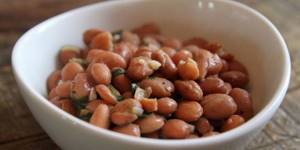
- Breakfast: 20 g of cheese, a glass of milk, 2 bell peppers.
- Lunch: 100 g boiled broccoli (salted).
- Afternoon snack: 6 lettuce leaves, 40 g cheese.
- Dinner: 100 g of boiled red meat.
- Breakfast: a glass of kefir, 2 tomatoes, 20 g of cheese,
- Lunch: 200 g eggplant stewed with garlic, 20 g cheese.
- Afternoon snack: 2 cucumbers, 40 g cheese.
- Dinner: 100 g of boiled white chicken meat, 50 g of celery root.
Cheese and vegetable omelet
Cheese and vegetable omelette is a dietary dish for 300 Kcal.
Composition of ingredients
To prepare an omelet you will need:
- chunky or very dense spreadable cheese;
- half a bell pepper;
- greenery;
- 4 cherry tomatoes;
- a pair of eggs;
- some milk;
- salt and spices.
Step-by-step cooking process
- Eggs should be broken and mixed with milk.
- Then you need to add salt, spices, finely chopped bell pepper and herbs.
- Next, you need to pour the mixture into a heated frying pan.
- Then you need to finely chop the processed cheese and sprinkle it evenly over the omelette.

- Then you need to cut the cherry tomatoes in half and place them on the omelette with the cuts down.
- Then you should cover the frying pan with a lid and fry the omelette for 5 - 7 minutes.

